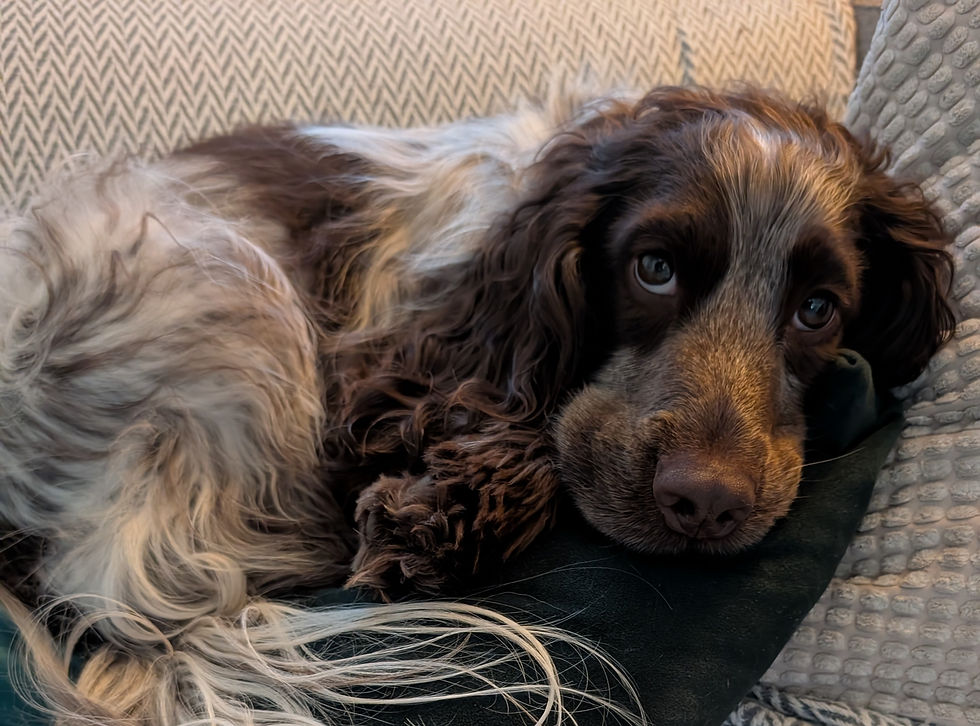Something’s Off: How to Spot Pain in Your Dog (and What to Do About It)
- Jun 6
- 4 min read
Frank’s taking a bit of a break from mantrailing. Not because he wants to. Because he has to.
What started as a gut feeling of "something’s not quite right" quickly led to a diagnosis that hit hard: hip dysplasia and significant joint incongruence in his shoulder. He’s only five. But he’s been hiding pain for a long time.
I raised concerns with vets over the years. He’s always moved a little strangely, tired quickly, and just seemed… off. But every time I asked, the answer was the same:
"He’s a Spaniel. Probably just knocked himself. Rest and anti-inflammatories."
Eventually, it became too obvious to ignore. So I pushed to be taken seriously, and I’m so glad I did. Because once we had answers, we could actually help him.
This blog isn’t about Frank’s diagnosis, but about what it taught me: that pain in dogs doesn’t always look how we expect. It’s about the many dogs like him; hiding discomfort in plain sight. So, if you’ve ever had that gut feeling that something’s not quite right, I hope this helps you trust it.
Why Dogs Don’t Always Show Pain Clearly
Pain in dogs is often invisible .. at first at least.
Unlike humans, dogs don’t tend to whine or limp unless the pain is severe. Evolution taught them to hide it. In the wild, obvious signs of pain could mean danger. That instinct still exists in our pets. So they adapt. They compensate. And unless we’re actively looking, we might not notice the signs until things are well advanced.

What Pain Actually Looks Like (Hint: It’s Not Always Limping)
Pain isn’t always loud or obvious — more often, it’s subtle changes that are easy to miss or dismiss. Here are some signs to keep in mind:
Behaviour shifts: A friendly dog becomes withdrawn or snappy. They might avoid touch, seem unusually clingy, or lose interest in play, food, or training.
Movement changes: You might notice stiffness, hesitation on stairs or jumps, slower transitions (like lying down or getting up), or odd weight-shifting.
Changes in coat texture or appearance: Areas of pain can cause the fur to change. What was once smooth and flat may become wavy, puffy, or lie differently over sore muscles or joints. For example, a previously sleek back might suddenly show a wave or kink near the hips.
Other clues: Excessive licking of joints or paws, restlessness, unexplained panting, frequent “shake offs,” or suddenly ignoring cues they usually know — often because they’re trying to protect themselves.
It’s easy to brush these off as age, stubbornness, or just “one of those days.” But if you ever find yourself saying, “He’s just not himself,” — that’s worth listening to. You know your dog best.

Worried Your Dog Might Be in Pain? Here’s What to Do
First things first: trust your gut. If something feels off, it probably is. You’re not being dramatic, and you’re not overreacting. You’re being your dog’s voice. And that matters.
Start by booking a vet appointment, ideally with someone who will actually watch your dog move, not just give them a quick once-over on the table. And if you leave feeling unsure or unheard? Ask for a second opinion. You’re not being “that client”, you’re being an advocate.
From someone who works with dogs daily, and still missed the signs in her own, here’s what I’ve learned:
Take videos. Dogs are great at hiding pain in the clinic. Catch those small moments at home.
Be specific. “She struggles to get up after naps” is more helpful than “She’s just not herself.” - Use the free PDF to note everything down in one place
Track patterns. Keep a simple diary noting stiffness, changes in mood, sleep, appetite, or playfulness.
Ask questions. If pain continues without answers, don’t be afraid to push for imaging or further investigation.
Follow your instincts. If something doesn’t sit right, it probably isn’t. You know your dog best.
To help, I’ve created a FREE printable Pain Checklist with common signs and space to note what you’re seeing.
Stick it on the fridge. Pop one in your trailing bag. Use it whenever something feels off. It’s a small thing, but it could make a big difference.
It can also help to involve:
A physiotherapist or rehab vet
Pain specialists or vets with experience in orthopaedics
An osteopath or holistic practitioner working alongside your vet
Final Thoughts
Pain isn’t always dramatic. It creeps in. It gets normalised. And all too often, it’s written off as “old age” or “bad behaviour.”
But pain affects everything; your dog’s mood, movement, interactions, even sleep. And they can’t tell you directly. They rely on you to notice the shift, trust your instincts, and speak up on their behalf.
Frank’s story could have gone very differently. I could’ve kept accepting “He’s just being a Spaniel.” But I didn’t, and now, he’s getting the support he needs, and the comfort he deserves.
So if your dog seems “not quite right,” please don’t wait. Look again. Ask more questions.
Because even if pain doesn’t shout, your dog is still counting on you to listen.
Happy Mantrailing!
Danielle & Frank
The Frank 'n' Scents Mantrailing Team








Comments